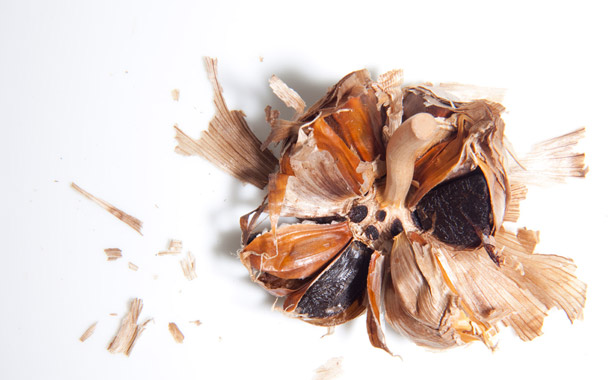Every so often an ingredient takes the American chef community by storm, quickly turning from obscure specialty to pantry staple. Some are flash-in-the-pan fads (argan oil, for example, kind of came and went a decade ago); some have staying power (is anyone else tired of pork belly yet?). So what is this year’s hot product? Beef tendon? Smoked trout roe? Maybe, but there’s another ingredient finding favor in restaurant kitchens from New York to San Francisco. Here’s a hint: It’s sweet, it’s sticky, and it’s black. It’s black garlic, and it’s becoming more accessible to curious home cooks as well.
Black garlic has long been used medicinally in Korea and Japan, but the aged, fermented bulbs have just recently become available in the United States (the sole manufacturer and supplier here is a company called Black Garlic Inc.). Historically, the raw garlic was sealed in ceramic or earthenware pots and left to do its thing; today, the same complex transformation takes place in specially designed ovens under controlled temperature and humidity. What was once a dark and mysterious ingredient has come out into the limelight, with a boost from food blogs and an appearance on Bravo’s Top Chef. Although the bulk of what is available to consumers is still produced in South Korea, Kim plans to eventually apply the all-natural aging technique to California-grown garlic.
Local or not, the product has a mellow, umami-rich flavor that has attracted chefs—like David Kinch of Manresa in Los Gatos, CA, who was surprised not only by its black color but also by its distinct sweetness. “My first thought was a dessert application,” Kinch says. “The texture is what makes it unique, though. It is almost custard-like, very pleasing.” He likes to change the dynamics of a dish by using black garlic in place of conventional roasted garlic. “I love it with roasted chicken,” he says.
George Mendes, chef and owner of the recently opened Aldea in New York City, agrees. Aldea’s opening menu features a chicken entrée were the garlic is “infused into an intense jus, but also served on a small skewer for the customer to enjoy its purity,” says Mendes. He is drawn to the hints of chocolate and molasses, flavors that emerge as the bitterness is muted. He first encountered the product while working a stint in the kitchen of El Bulli in Spain. (Ferran Adrià discovered black garlic for himself a few years earlier while traveling in Japan.) Mendes continues to experiment with various applications. “I’m thinking of making a tomato confit with slivers of the garlic to see how the two interact.”
Because Western chefs aren’t locked into a specific frame of reference for a “new” ingredient like black garlic, they are, in a sense, free to make their own creative associations. Rick Tramonto of Chicago’s Tru employs the garlic in two ways: in a marinade for mackerel ceviche, and sliced thin as a garnish for seared scallops (where the garlic slivers resemble delicate shavings of black truffle). “I first read about [black garlic] six years ago,” Tramonto says. “I love its soft and chewy texture.”
It’s that very texture that Judy Shertzer of Terra Spice Company uses as a selling point. “I often describe it as a sweet and garlicky gummy candy with hints of licorice and aged balsamic vinegar,” she says. Shertzer is creating converts across the country, making Terra Spice the biggest distributor of Mr. Kim’s garlic. When Eric Ripert tasted a sample last summer, he immediately put it to use here at Le Bernardin in a monkfish dish, with a pan-Mediterranean marriage of dried Persian limes and za’atar spice. (Incidentally, that dish became one that Top Chef winner Hosea Rosenberg had to replicate during a challenge last season.)
As a pastry chef, I couldn’t pass up the notion of working black garlic into a dessert. When approaching an unconventional ingredient like this, I often find that ice cream is a good place to start. After freeing the sticky cloves from their papery skin, I infused a handful of them into milk, which I used as the base for the ice cream. I was hoping to capture the mellow sweetness, but I have to say that the resulting dessert displayed a bit more of the original garlic flavor than I had anticipated. It wasn’t bad, just perhaps slightly more interesting than delicious. So, though I have yet to work the dark bulbs into the dessert menu, I haven’t given up. Just as more and more chefs and home cooks continue to explore the virtues of black garlic, I will, too.




 Pinterest
Pinterest


